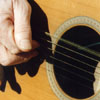Pause for a moment to listen. You might be hearing the fan in your computer, traffic noise, the rhythm of music, bird songs or just the clatter of busy life around you. All of this is caused by sound energy passing through the air from the source of the sound to reach your ear.
Inside the ear, the arriving sound energy causes the particles in your ear drum to move back and forward, or oscillate. This oscillation is also called vibrations. These vibrations produce electrical signals that are transmitted through nerves to the brain where you interpret the signals as sounds.
Sound is caused by regular oscillating that produce regions of compression (high pressure) and rarefaction (low pressure) that move through a substance. Sound not only travels through air, it can travel through any substance, solid, liquid or gas. Whales can hear other whales across whole oceans through water, an Earthquake is low frequency sound moving through the solid Earth.

|
Sound |
How sound travels
The sounds you are hearing are a series of compressions and rarefactions
travelling through air. A vibrating object compresses the air and sound
waves move from the source, much like waves in water if you drop a stone
into it. These sound waves can carry great distances depending on their
loudness and frequency.

|

|

|
Sound doesn't only travel through air. When you hear sounds outside the room you are in, the waves must have passed through solid objects such as brick, wood or glass. In every case the energy is transmitted by interactions between particles in the object. Sometimes you can feel vibrations caused by sound, such as through the floor of a room where a band is playing loudly.
The speed of sound
This varies depending on many variables. In still air, under normal conditions,
sound travels at about 340 metres every second. In solids, the speed increases
- in brick, it travels about ten times faster, in steel, fifteen times
faster and in water, about four times faster. This difference in speed
is partly explained by the strongly bound, tighter packing of particles
in solids and liquids. Some solids, like steel, carry sound very fast
indeed over long distances. This is because the particles in steel are
bound strongly together making the steel very "springy".
Knowing this, think about how sound travels in plasticine or clay. Not well? Plasticine is not known for its ability to spring and is not a good conductor of sound.
What about sound in space? How fast does sound travel in space?
Sound in space
 The Universe has enormous energy, and stars like our Sun are giant
nuclear furnaces producing massive eruptions, yet we cannot hear any of
it.
The Universe has enormous energy, and stars like our Sun are giant
nuclear furnaces producing massive eruptions, yet we cannot hear any of
it.
This is because sound needs a medium to travel in, and space has such a low density of particles that the sound energy cannot be transmitted. Sound doesn't travel in space at all. This is a good thing, as we would be deafened by the intensity!
More sound or less sound
 Sound can be enhanced or reduced to suit our needs. For example,
an acoustic guitar generates sound when a player plucks the strings.
Sound can be enhanced or reduced to suit our needs. For example,
an acoustic guitar generates sound when a player plucks the strings.
The resulting vibrations are transmitted to the large wooden parts and these vibrate as well. This means that more air can be compressed and the sound is made louder, or amplified. On the other hand you might want to reduce sound transmission so materials that absorb energy can be used. Examples are ear protectors, car mufflers and the walls of concert halls where you might want to reduce sound waves after reflection from the walls.
Try changing sounds by this simple experiment. Listen to the fan in your computer, then cover both ears with your hands. What do you notice? Now press your ear to the desk. Your computer is on. What do you notice now? What is happening?
Wavelength and frequency
The frequency of vibration of the producer of the sound affects how close
the sound waves are to each other. The closer the compressions are, the
more frequently they arrive at the ear. A high frequency sound has more
compressions per cm than a low frequency sound. Our brains interpret high
sound frequency as high pitch and low frequency as a low pitch. A mosquito
produces a high pitched sound and a tuba can produce a low pitched sound.
It's all to do with vibrations.
|
|
| Copyright owned by the State of Victoria (Department of Education and Early Childhood Development). Used with Permission. |